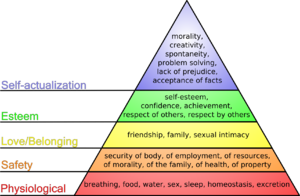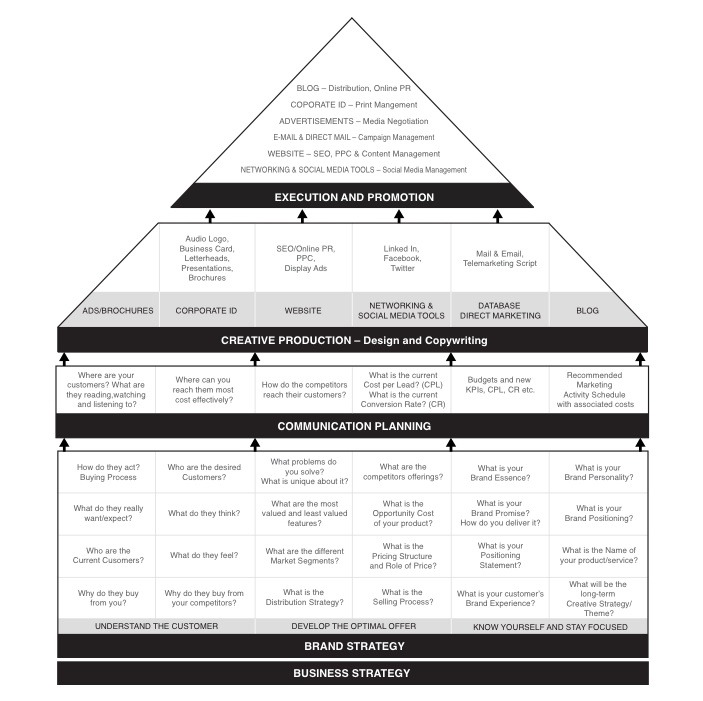
by admin | Jan 22, 2011 | Blog

Image via Wikipedia
Here is a list of the most common reasons of why people buy aligned to Maslow’s Hierarchy of Needs:
SURVIVAL: (Warmth, Water, Food, Sleep, Health, Sex) or what is commonly referred to as BASIC NEEDS!
- To be warm
- To satisfy hunger
- To satisfy thirst
- To rest and regenerate
- To avoid pain
- To look younger
- To attract the opposite sex
SAFETY / SECURITY: (Physical Safety, Comfort, Freedom from Threats, Economic Security)
- To be safe
- To protect the family
- To protect possessions
- To save money
- To make money
- To look younger
- To save time
- To save money
- To be fit and healthy
- To be organised
- To escape stress
- To avoid effort
- To make work easier
- To become comfortable
- To be more efficient
- To save energy
- To be clean
- To gain convenience
LOVE, BELONGING / SOCIAL ACCEPTANCE:
- To attract the opposite sex
- To express love
- To receive love
- To be clean
- To be in style
- To avoid criticism
- To attract praise
- To be popular
- To be organised
- To be fit and healthy
- To be understood
- To be informed
SELF-ESTEEM: (Prestige and Status, Recognition of Intelligence, Recognition of Strength)
- To be individual
- To have fun
- To protect reputation
- To save environment
- To feel superior
- To look younger
SELF-ACTUALISATION: (Autonomy, Creativity, Peak Experiences, Benevolence)
- To be independent
- To have privacy
- To be challenged
- To be innovative
- To discover new things and experiences
- To be spontaneous
- To leave a legacy
- To give to others
Understanding the drivers behind reasons for buying will allow marketers to better satisfy customer needs through both better product and service design as well as improved communication!
Examining the above reasons for buying it is no wonder that our society is pre-occupied with attracting the opposite sex and staying young! Nor is it surprising that luxury goods are now in many ways “available” to most people and there is now a rise of the “uber premium goods and services”


by admin | Jan 22, 2011 | Blog

Image via Wikipedia
Here is a list of the most common reasons of why people buy aligned to Maslow’s Hierarchy of Needs:
SURVIVAL: (Warmth, Water, Food, Sleep, Health, Sex) or what is commonly referred to as BASIC NEEDS!
- To be warm
- To satisfy hunger
- To satisfy thirst
- To rest and regenerate
- To avoid pain
- To look younger
- To attract the opposite sex
SAFETY / SECURITY: (Physical Safety, Comfort, Freedom from Threats, Economic Security)
- To be safe
- To protect the family
- To protect possessions
- To save money
- To make money
- To look younger
- To save time
- To save money
- To be fit and healthy
- To be organised
- To escape stress
- To avoid effort
- To make work easier
- To become comfortable
- To be more efficient
- To save energy
- To be clean
- To gain convenience
LOVE, BELONGING / SOCIAL ACCEPTANCE:
- To attract the opposite sex
- To express love
- To receive love
- To be clean
- To be in style
- To avoid criticism
- To attract praise
- To be popular
- To be organised
- To be fit and healthy
- To be understood
- To be informed
SELF-ESTEEM: (Prestige and Status, Recognition of Intelligence, Recognition of Strength)
- To be individual
- To have fun
- To protect reputation
- To save environment
- To feel superior
- To look younger
SELF-ACTUALISATION: (Autonomy, Creativity, Peak Experiences, Benevolence)
- To be independent
- To have privacy
- To be challenged
- To be innovative
- To discover new things and experiences
- To be spontaneous
- To leave a legacy
- To give to others
Understanding the drivers behind reasons for buying will allow marketers to better satisfy customer needs through both better product and service design as well as improved communication!
Examining the above reasons for buying it is no wonder that our society is pre-occupied with attracting the opposite sex and staying young! Nor is it surprising that luxury goods are now in many ways “available” to most people and there is now a rise of the “uber premium goods and services”


by admin | Jan 22, 2011 | Blog

Image via Wikipedia
Is there anything more important than understanding the customer?
The ability of the entrepreneur to put themselves into the shoes of their customers or prospects and to see the world from their perspective is probably the single most important characteristics of successful business people.
Some marketers call it “marketing by walking around” and many sales professional often refer to the ancient Greek philosopher Epictetus quote “We have two ears and one mouth so that we can listen twice as much as we speak.”
Being a keen student of human behavior, observing, listening, and asking questions is the key.
Here are some of the most important questions you should be asking:
- Who are the current customers?
- Who are your desired customers?
- What do they really want / expect?
- What dot they THINK? Rational Benefits
- What do they FEEL? Emotional Benefits
- How do they ACT? What is the BUYING PROCESS? What people SAY is often very different to what people DO!
- Why do customers buy from you?
- Why do they buy from your competitors?
The next entry will provide you with just about every conceivable reason of why people actually buy!

by admin | Jan 22, 2011 | Blog
THE 1-PAGE PLAN FOR DESIGNING, BUILDING AND MAINTAINING YOUR MARKETING HOUSE.
Starting at the bottom and working your way up will give you an incredible advantage over most of your competitors.
The estimates are that only 3% to 5% of Australian small businesses starting from scratch prepare a business and marketing plan; that is, know that their business is feasible and have a formal plan to steer that business towards success.
It is then no surprise that CPA Australia estimates that one in three new small businesses in Australia fail in their first year of operation, two out of four by the end of the second year, and three out of four by the fifth year. Just approximately 8% of small businesses succeed beyond five years. These statistics are similar across many of the western economies.


by admin | Jan 21, 2011 | Blog
Marketing is an ongoing process, similar to designing and building a house.
It is then important to maintain and build the value of your marketing properties and prevent this value being depreciated through neglect of infrastructure or promotional activity by competitors.
Firstly the structure must be designed correctly, beginning with the foundations that will support any future building.
Unfortunately, many businesses do the equivalent of trying to put a roof on a house with no foundations or walls by asking marketers to jump straight into execution and promotion. And many marketing suppliers oblige them!
By demanding that marketing people produce a Website, Advertisement, Brochure, etc. before the business has answers to strategic questions and clear plans for long term communication, inevitably always ends up wasting time and money.
To get the best return on the marketing investment, time needs to be dedicated to answer the questions that assist in building a solid foundation for the marketing of the business. By starting at the bottom and working up, the business building process will be shorter, less painful and more profitable.


by admin | Jan 21, 2011 | Blog, Strategy

Image via Wikipedia
Is there anything more important than understanding the customer?
The ability of the entrepreneur to put themselves into the shoes of their customers or prospects and to see the world from their perspective is probably the single most important characteristics of successful business people.
Some marketers call it “marketing by walking around” and many sales professional often refer to the ancient Greek philosopher Epictetus quote “We have two ears and one mouth so that we can listen twice as much as we speak.”
Being a keen student of human behavior, observing, listening, and asking questions is the key.
Here are some of the most important questions you should be asking:
- Who are the current customers?
- Who are your desired customers?
- What do they really want / expect?
- What dot they THINK? Rational Benefits
- What do they FEEL? Emotional Benefits
- How do they ACT? What is the BUYING PROCESS? What people SAY is often very different to what people DO!
- Why do customers buy from you?
- Why do they buy from your competitors?
The next entry will provide you with just about every conceivable reason of why people actually buy!


by admin | Jan 21, 2011 | Blog

It is then no surprise that CPA Australia estimates that one in three new small businesses in Australia fail in their first year of operation, two out of four by the end of the second year, and three out of four by the fifth year. Just approximately 8% of small businesses succeed beyond five years. These statistics are similar across many of the western economies.
by admin | Jan 21, 2011 | Blog, Strategy
Marketing communications are an ongoing process, similar to designing and building a house.
It is then important to maintain and build the value of your marketing properties and prevent this value being depreciated through neglect of infrastructure or promotional activity by competitors.
Firstly the structure must be designed correctly, beginning with the foundations that will support any future building.
Unfortunately, many businesses do the equivalent of trying to put a roof on a house with no foundations or walls by asking marketers to jump straight into execution and promotion. And many marketing suppliers oblige them!
By demanding that marketing people produce a Website, Advertisement, Brochure, etc. before the business has answers to strategic questions and clear plans for long term communication, inevitably always ends up wasting time and money.
To get the best return on the marketing investment, time needs to be dedicated to answer the questions that assist in building a solid foundation for the marketing of the business. By starting at the bottom and working up, the business building process will be shorter, less painful and more profitable.
Brand recognition alone is useless. Today every plumber has a brand and a slogan on the side of his truck. The world is drowning in brands and slogans
Read more
by admin | Jan 20, 2011 | Blog
How do you differentiate your product or service when there is little or no difference?












Recent Comments